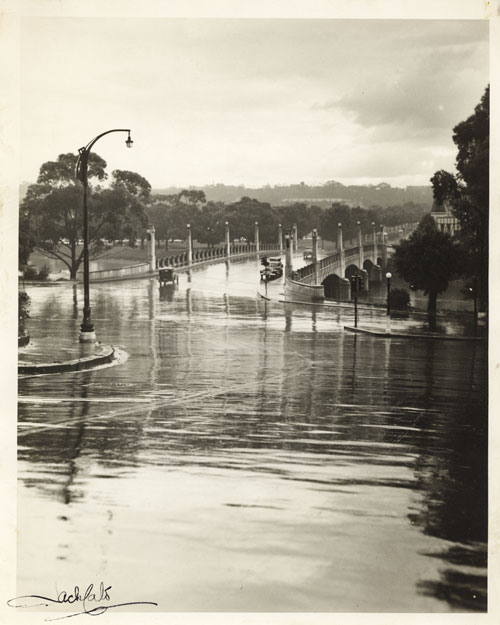|
more on Jack Cato
Jack Cato's Hoddle Bridge (Melbourne)
Gael Newton AM, October 2025
 |
| Jack Cato, Hoddle Bridge, Melbourne, early 1940s |
Jack Cato made this shimmering wet day study of a few cars crossing Hoddle Bridge over the Yarra River as seen from a distance up the southern side in the 1940s. The Bridge was at the crossing where a punt had operated from the mid to late 19th century. A footbridge had existed since 1895 but a roadway was urgently needed in the 1930s.
While under construction in 1937-38 the Bridge was known as Old Punt Road Bridge. When opened on 22 December 1938 it was named after the colonial surveyor Robert Hoddle. It is handsome streamlined bridge made of reinforced concrete with heavy piers and stanchions, elegant art deco styled lamp posts and railings.
In contrast to the view in the photograph with a few cars crossing the bridge, today it is rare to not join slow moving queues of double lanes of vehicles making their way slowly across this bridge. It is a very congested crossing of the Yarra River.
The print is different in style from Cato’s darker toned matt surface exhibition prints and the dramatic and moody urban scenes he made for his 1949 book on Melbourne, that was published by Georgian House. The ninety nine Cato prints in the Melbourne book were often heavily worked on with clouds added as required.
Gloss prints like the Hoddle street image were for reproduction in the 1930s rather than exhibition or fine art publishing. This print is clearly signed in ink lower left in the image.
Cato was trained in Pictorialist art photography in London in the 1909-13 which favoured developing a print with soft focus romantic composition close in style to the graphic arts. Like many commercial art photographers in the 1920s-30s, Cato developed a hybrid Pictorial-Modern style with more design and natural light than the earlier style.
This image of the approach to Hoddle Bridge is modern but keeps a touch of previous Pictorialism. This is in contrast to his contemporaries, such as the younger Max Dupain, who were publishing in a more modernist hard edge architectural style when photographing architecture and urban scenes.
We do not know how much Jack Cato would have planned the photograph or whether he had seen this viewpoint in advance and took advantage of the Melbourne rain for the effect he sought. The bridge is not the principal focus. The glistening water takes up most of the foreground. He probably used a larger format stand camera but possibly a modern smaller format roll film Rolleiflex camera.
As mentioned above, taking such a photo today would almost be impossible. The view of the roads almost at any time of the day today would be one of bumper to bumper traffic in double lanes in both directions with lines of vehicles attempting to enter from the riverside roadways. Today no amount of Pictorialist application could deliver anything aesthetically similar to Cato's photograph. Today's urban realities of congestion and impatient drivers would deliver a much less romantic and a far grittier image.
Cato's Hoddle Bridge photo has a photographic approach suited to the era in which the image was made. The photograph is a lovely print. Cato has captured a special moment of a main urban thoroughfare in this city of Melbourne at a time when so much of the 'modern' had an aesthetic beauty - something that lingers today - but in many cases - only just!
Having done a lot of work on Jack Cato as a photographer and historian, it is nice to have this signed photograph.
For a selection of Jack Cato's photographs - click here
For more about Jack Cato - click here
For more of 'On Our Collections' - click here
For more on Max Dupain - click here
For more essays by Gael Newton - click here
|
